How To Master Transitional Design: A Timeless, Elegant Look

An introduction to transitional design
Transitional design is a popular style that blends traditional and modern elements to create a timeless aesthetic.
This type of design is perfect for those who appreciate classic beauty and want a look that won’t go out of style.
It is possible to adapt transitional style into any space and incorporate both modern and traditional furnishings, finishes, and textiles.
If you’re looking for a timeless look that will never go out of style, transitional design may be perfect for you!
In this article, we explore what transitional design is and take a look at some of its key elements. We also offer some advice about how to get started with incorporating transitional design into your home.
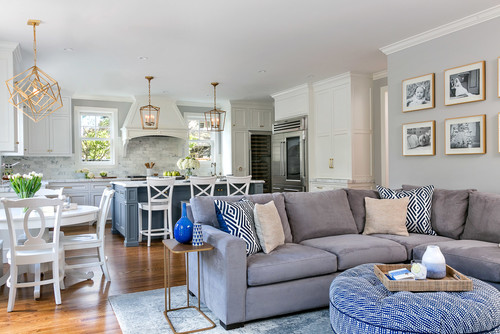
Transitional Living Room, San Francisco
What is transitional design?
Transitional design is a blend of traditional and modern design elements.
This type of design is characterized by clean lines, neutral colors, and a mix of both traditional and contemporary furnishings.
Transitional design is perfect for those who want a timeless look that is both elegant and stylish.
The key to transitional style is to find the perfect balance between traditional and modern elements.
Transitional design incorporates the same basic principles of traditional design, but with a modern twist.
For example, transitional furniture is often clean-lined and simple, but it can also incorporate traditional details such as tufting or carved wood.
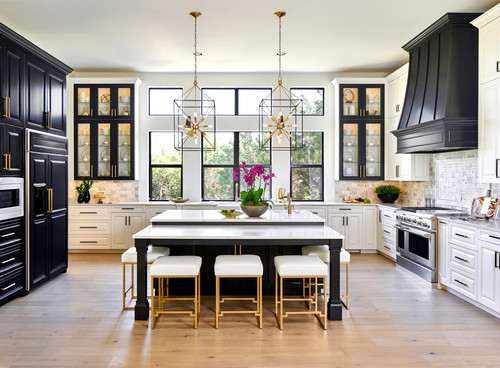
What are the elements of transitional design?
There are a few key elements that transitional design typically incorporates. These include:
Clean lines
Transitional style is characterized by clean, simple lines.
This type of design is often devoid of embellishments or ornate details.
Items that have a transitional design are typically sleek and have an “uncluttered” feeling about them.
Incorporating furniture with clean lines is a great way to achieve a transitional look.
Neutral Colors
Transitional style embraces timeless elegance and often incorporates neutral colors, such as black, white, gray, or beige.
You can certainly incorporate pops of color into a transitional space, but the overall feel should be calm and serene.
This type of design is perfect for those who want a classic yet comfy look that won’t go out of style.
A neutral color palette allows transitional style to be adaptable to any space and also makes it easy to personalize.
Blended Styles
Transitional design is all about mixing traditional and contemporary elements.
This type of design often incorporates both modern and traditional furniture, finishes, and textiles.
For example, it is common to see simple transitional furniture that also has some traditional details, such as tufting or carved wood.
Texture
Incorporating texture into a transitional space adds interest and depth while still allowing you to keep a neutral color palette.
Transitional style often incorporates both smooth and textured surfaces.
For example, a transitional space may incorporate marble countertops with linen curtains or a fluffy, textured rug under a leather sofa.
Contrast
Visual interest can be created through the use of contrast.
Transitional design often incorporates both light and dark colors, as well as both matte and glossy finishes.
For example, a transitional space may have black and white wallpaper with a matte finish next to a dark wood floor with a glossy finish.
Metallic Accents
Metallic accents are often used in transitional style to add a touch of luxury. Transitional spaces often incorporate gold, silver, or bronze details.
These metallic accents can be used in items such as hardware, lighting, or decor.
Using metal finishes is perfect for adding a bit of sparkle and sophistication to a transitional space.
Functionality
Functionality is key in transitional design.
Transitional spaces are typically very livable and easy to use. This type of design is all about creating a living area that is both beautiful and practical.
Incorporating items such as hidden storage and multipurpose furniture is a great way to create a transitional space that is both functional and stylish.
Wood Tones
Wood tones are often used in transitional design to add warmth and depth.
Transitional spaces may incorporate both light and dark wood tones.
This is a lovely way to add visual interest and create a more inviting space while still keeping a neutral color palette.
Wood is also a great way to add texture and contrast to a transitional space.
Contemporary Art
Contemporary art is often used in transitional design to add a touch of personality.
Transitional design relies on contemporary art to add a modern element. You can use contemporary artwork on the walls or incorporate sculptures or other 3D art into your rooms.
Contemporary art pieces may be more abstract, include some bolder colors, or incorporate a variety of textures.
Art with a contemporary feel can really help to make a transitional space feel more personal and unique.
Keep in mind, though, that the overall design goal is to create a harmonious, inviting space. Your art pieces should complement the overall aesthetic.
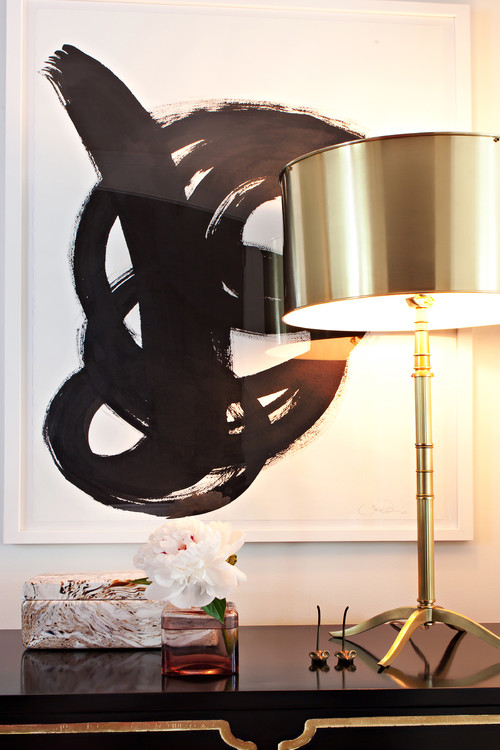
Transitional Living Room, Houston
A Blend of Masculine and Feminine Styles
Transitional design often incorporates both masculine and feminine elements.
This is a great way to add interest and create a more balanced space.
Using a mix of masculine and feminine elements can help to create a transitional space that is both stylish and inviting.
Masculine transitional elements may include:
- dark wood tones
- leather furniture
- metal accents
Feminine transitional elements may include:
- pastels
- delicate fabrics
- floral patterns
How to Add Transitional Design to Your Home
Now that you know a little bit more about transitional design, you may be wondering how you can incorporate this popular style into your own home.
Transitional design is all about finding the perfect balance between traditional and modern elements.
If you want to achieve a transitional look, consider taking these steps:
Transition to a neutral color palette
Transitional design is typically characterized by a calm, serene color scheme.
One way to transition to this color palette is to start by painting your walls a neutral color.
You can then add in some subtle pops of color with art, accessories, and furnishings.
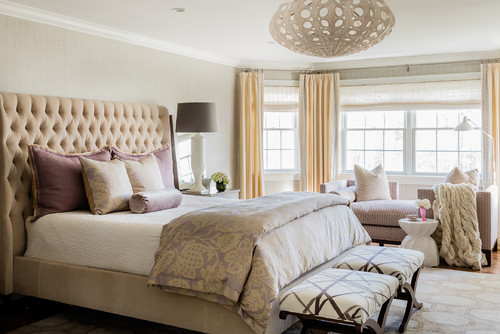
Add some transitional furniture pieces
When choosing furniture for your transitional space, look for pieces that combine both traditional and modern elements.
Transitional furniture is characterized by clean lines and a simple design.
You can also add some transitional elements by incorporating mixed materials, such as a wood table with metal legs or a leather sofa with a fabric chair.
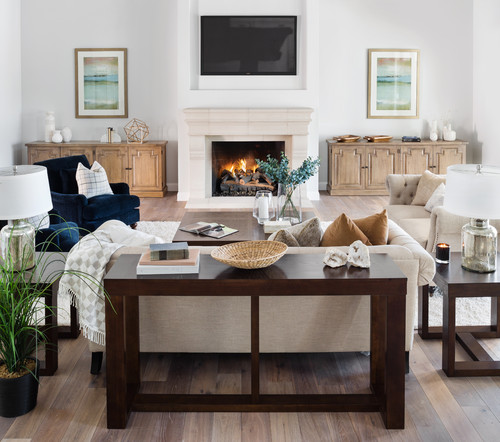
Incorporate transitional lighting
Lighting is an important part of transitional design. Look for lighting fixtures that combine both traditional and modern elements that include clean lines and a simple design.
Consider something like a metal chandelier with glass shades or a table lamp with a more luxurious fabric shade and a wooden base.
Choose transitional accessories
When accessorizing your transitional space, look for pieces that combine both traditional and modern elements.
For instance, you could incorporate pieces with mixed materials, such as a ceramic vase with a metal stand or a glass bowl with a wooden base.
When adding transitional accessories, also consider adding pieces with some bolder complementary colors or interesting textures.
Incorporate traditional and contemporary elements
A great way to do this is to mix and match different furniture styles.
For example, you could pair a traditional sofa with a contemporary coffee table or a transitional chair with a traditional end table.
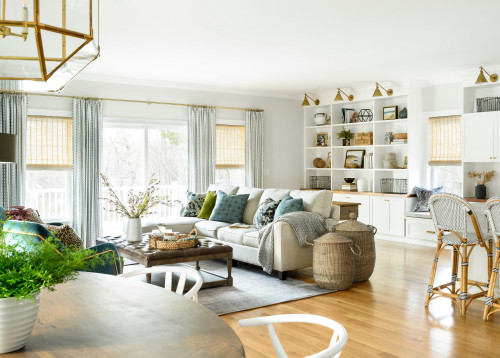
Add more texture
Use different fabrics, finishes, and materials to accomplish this.
For example, you could add a sisal rug to your living room or use velvet curtains in your bedroom.
Buy some transitional art pieces
Contemporary art is often used in transitional design to add a touch of the unexpected.
Transitional spaces typically incorporate both traditional and contemporary art, and we are guessing you already have some more traditional pieces.
Looking for a few simple designs with more of a contemporary feel will add interest and really make the space your own.
Create a balanced space
When creating a transitional space, it’s important to find the perfect balance between traditional and modern elements.
As you mix and match different furniture styles, colors, and textures, keep an eye on the overall balance of the space.
You want to create a space that feels harmonious and inviting, not cluttered and chaotic.

Conclusion
When done well, transitional design creates a timeless, elegant look that is perfect for those who want a classic yet stylish space.
If you want to start incorporating transitional design into your home, consider painting your walls a neutral color, adding some transitional furniture pieces, and choosing transitional accessories.
Remember to mix and match different elements to create a balanced space. With these tips, you’ll soon be on your way to achieving the perfect transitional space.
What’s your favorite transitional design element? Let us know in the comments below!
If you enjoyed this article, be sure to check out our other blog posts on transitional design for more inspiration.
And if you’re looking for transitional furniture and accessories, take a look at our list of Transitional Decor Must-Haves.
3 comments
Comments are closed.